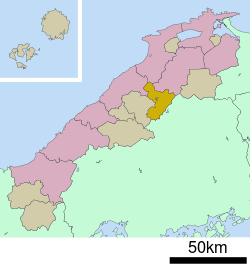Iinan, Shimane
| Iinan 飯南町 | ||
|---|---|---|
| Town | ||
|
Iinan town hall | ||
| ||
 Location of Iinan in Shimane Prefecture | ||
 Iinan Location in Japan | ||
| Coordinates: 35°0′N 132°43′E / 35.000°N 132.717°ECoordinates: 35°0′N 132°43′E / 35.000°N 132.717°E | ||
| Country | Japan | |
| Region |
Chūgoku San'in | |
| Prefecture | Shimane Prefecture | |
| District | Iishi | |
| Area | ||
| • Total | 242.84 km2 (93.76 sq mi) | |
| Population (March 1, 2017) | ||
| • Total | 4,908 | |
| • Density | 20/km2 (52/sq mi) | |
| Symbols | ||
| • Tree | Beech | |
| • Flower | Peony | |
| Time zone | UTC+9 (JST) | |
| City hall address |
890 Shimoakana, Iinan-machi 690-3513 | |
| Website |
www | |
Iinan (飯南町 Iinan-chō) is a town located in Iishi District, Shimane Prefecture, Japan.
It was formed on January 1, 2005 from the merger of the towns of Tonbara and Akagi, both from Iishi District.
As of March 1, 2017 the town has a population of 4,908 and a density of 20 persons per km². The area is 242.84 km².
Geography
Located on the border of Shimane Prefecture and Hiroshima Prefecture, the Gōno River flows to its west. The town is part of the Hiba-Dōgo-Taishaku Quasi-National Park.[1]
Mountains: Mt. Oyorogi, Mt. Kotobiki, Mt. Mengame
Rivers: Kando River, Tonbara River, Akana River, Ono River (Tributary of Kando River)
Lakes:Lake Kijima (Kijima Dam lake)
Subdivisions
- Akana
- Kijima
- Oda
- Tani
- Tonbara, formerly part of Tonbara, Shimane
Surrounding municipalities
Population
Iinan Population Change over Time[2]
| Historical population | |||||||||||||||||||||||
|---|---|---|---|---|---|---|---|---|---|---|---|---|---|---|---|---|---|---|---|---|---|---|---|
|
| ||||||||||||||||||||||
| (Population of Tonbara and Akagi added together before 2005) | |||||||||||||||||||||||
Transportation
National Highways
- National Highway 54
- National Highway 184
Roadside Stations
- Roadside Station Akagi Plateau
- Roadside Station Tonbara
There is no railroad access to Iinan.
Notable places
AkanaSetoyamaCastle Distant view
- Akana Castle
- It is an old castle located on top of a hill in the Akana area of the town.
- Mount Mengame
- Mount Kotobiki
- Akana Marshland
- Kotobiki Camp Area
- The Kotobiki Camp Area is located at the foot of Mount Kotobiki. It is open from late April to late October.[6]
References
- ↑ 考える社会科地図 Kangaeru Shakaika Chizu. 四谷大塚出版 Yotsuya-Ōtsuka Shuppan. 2005. p. 25.
- ↑ ja:飯南町
- ↑ (in Japanese) おかえりなさい!:島根県飯南町観光WEB
- ↑ (in Japanese) おかえりなさい!:島根県飯南町観光WEB
- ↑ (in Japanese) おかえりなさい!:島根県飯南町観光WEB
- ↑ (in Japanese) おかえりなさい!:島根県飯南町観光WEB
External links

- Iinan official website (in Japanese)
This article is issued from
Wikipedia.
The text is licensed under Creative Commons - Attribution - Sharealike.
Additional terms may apply for the media files.
